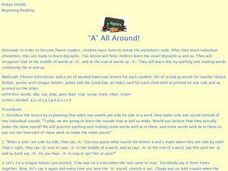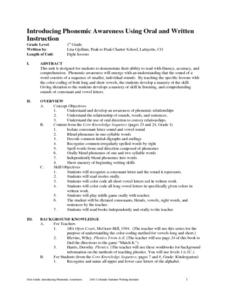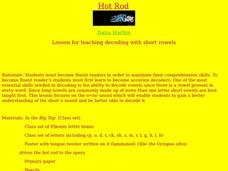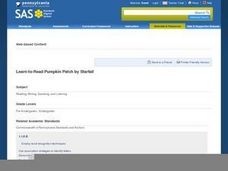Curated OER
Hop on Pop - Short 'o'
Students practice the alphabetic significance of the letter /o/ along with its awareness of phonemes in spoken words. They assess on construction paper the phrase, "We like to hop on top of Pop who's on top of a hot rock" written on it...
Curated OER
On-Level Small Group Phonics Lesson: ea /e/
Students explore /e/. In this phonics lesson, students decode words with "ea" representing the short e sound. Students read sentences and a short book that includes "ea" word practice.
Curated OER
Long Vowels with Silent 'E'
First graders read words with a silent E at the end. In this literacy lesson, the teacher explains how the silent E changes the sound a vowel makes, then students practice reading words. Students complete a worksheet with the teacher for...
Curated OER
Doctor : Open Wide And Say /o/
Students complete a variety of activities related to the short /o/ sound. As a class they recite a tongue twister, then trace and write the letter O. Students listen to a list of words and identify the words containing the short /o/...
Curated OER
Uggy the Umbrella Went Up, Up, Up!
Young scholars explore the short /u/ sound. They practice making the sound, noticing how their mouths move to make the sound. They recite tongue twisters with short /u/ words and practice writing the letter 'u'. With a partner, they...
Curated OER
"A" All Around
Spell and read words containing ai and ay. First and second graders identify vowel digraphs in written and spoken language. After a brief discussion on the combinations of letters that comprise digraphs, they practice reading and...
Curated OER
Read, Trace, and Color
For this printing words worksheet, pupils trace four words that have short vowels. Students color the pictures that illustrate each of the words.
Curated OER
Short E Word Practice
In this short e word practice worksheet, students will cut and glue final letters to make short e words that begin with m, b, p, j, l , and w.
Curated OER
Animal Alphabet
Students make a class animal book using the letters of the alphabet. They use a website imbedded in this plan to get pages with animals that begin with any of the 26 letters.
Curated OER
Olly Olly Oxenfree
Students review short vowel sounds. They complete a variety of activities as they discover how to say the short /o/ sound, write the letter 'o', and pronounce words with the short /o/ sound. They read stories with short /o/ words in them.
Curated OER
Introducing Phonemic Awareness Using Oral and Written Instruction
First graders demonstrate their ability to read with fluency, accuracy, and comprehension through phonemic awareness. They use a color-coding system to master the long and short vowel sounds and develop their skills in listening and...
Curated OER
Hot Rod
Learners complete a variety of activities related to the short /o/ sound. They spell different words containing the short /o/ sound using letter manipulatives, and with a partner read the book "Big Top." With their partner they count...
Curated OER
IzzyWizzy
Students complete a variety of activities related to the short /i/ sound. As a class they recite a tongue twister, then spell different words using letter manipulatives. Students then read the book "Tin Man Fix It," and identify the...
Curated OER
Lick Your Icky Sticky Fingers
Learners complete a variety of activities related to the short /i/ sound. As a class they recite a tongue twister, then spell different words containing the short /i/ sound using letter manipulatives. Students listen to the book "Liz...
Curated OER
Language Arts: Becoming Fluent Readers
First graders develop letter-sound correspondence skills by segmenting words according to their phonemes. Using letter tiles and letter boxes, they spell words called by the teacher. After reading several books with the teacher, 1st...
Curated OER
Aaa-aaa-aaa-choo!!
Students study the /a/ sound by mimicking the sound one makes when they sneeze. Next they work with a tongue twister, which they recite while stretching out the initial short a sound. Next, they practice writing the letter and read "A...
Curated OER
Things That Make You Say Aaaa!
Young scholars discuss how to identify the a=/a/ in spoken words. They discuss a meaningful representation for the sound and a letter symbol. They identify the /a/ sound in words. Students read a story and blink their eyes when they hear...
Curated OER
Iiiihhh...That's Icky Sticky
Students complete a variety of activities related to the letter "I" and the short /i/ sound. As a class they recite a tongue twister and write the letter "I." Students then listen to word pairs and identify the word in each pair that...
Curated OER
The Very Hungry Caterpillar
Students explore phonemes and short vowels. They identify /a/ (short a) sound in spoken words and learn a meaningful representation and a letter symbol for the sound. Students identify /a/ (short a) sound in words. They read "The Very...
Curated OER
Ew...That's Iiiicky!
Students complete a variety of activities related to the short /i/ sound. As a class they recite a short /i/ tongue twister, then spell words containing the short /i/ sound using letter manipulatives. In pairs they read the book "Tin...
Curated OER
Mr. Cloak Loads his Boat with Oats
First graders distinguish between the sounds for short vowel o and long vowel o. They are introduced to the vowel patterns that comprise long vowel sounds, with a particular emphasis on /oa/. They practice reading and identifying a...
Curated OER
Learn-to-Read Pumpkin Patch
Learners practice identifying and pronouncing the short letter "u" sound. For this phonetic awareness lesson, students access the Starfall.com website and follow the directions on the screen to reinforce the short "u" sound. Learners can...
Curated OER
O No!
First graders distinguish between short vowel a and long vowel O. They are introduced to the vowel-consonant-e pattern that changes short vowel sounds into long vowel sounds. They practice spelling words with the vowel-consonant-e pattern.
Curated OER
Short a and short i
Students participate in a lesson plan used in order to strengthen reading comprehension skills. They use spelling lists in order to sort them to the corresponding studied sounds. Vocabulary is used and students read them in context.

























